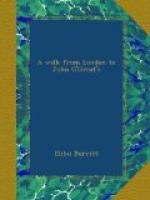PREFACE
Chapter I. Motives to the Walk—The Iron Horse and his Rider— The Losses and Gains by Speed—The Railway Track and Turnpike Road: Their Sceneries Compared.
Chapter II. First Day’s Observations and Enjoyment—Rural Foot-paths; Visit to Tiptree Farm—Alderman Mechi’s Operations— Improvements Introduced, Decried and Adopted—Steam Power, Under-draining, Deep Tillage, Irrigation—Practical Results.
Chapter III. English and American Birds—The Lark and its Song.
Chapter IV. Talk with an Old Man on the Way—Old Houses in England—Their American Relationships—English Hedges and Hedge-row Trees—Their Probable Fate—Change of Rural Scenery without them.
Chapter V. A Footpath Walk and its Incidents—Harvest Aspects— English and American Skies—Humbler Objects of Contemplation—The Donkey: Its Uses and Abuses.
Chapter VI. Hospitalities of “Friends”—Harvest Aspects: English Country Inns; their Appearance, Names and Distinctive Characteristics—The Landlady, Waiter, Chambermaid and Boots—Extra Fees and Extra Comforts.
Chapter VII. Light of Human Lives—Photographs and Biographs—The late Jonas Webb, his Life, Labors and Memory.
Chapter VIII. Threshing Machine—Flower Show—The Hollyhock and its Suggestions—The Law of Co-operative Activities in Vegetable, Animal, Mental and Moral Life.
Chapter IX. Visit to a Three-Thousand-Acre Farm—Samuel Jonas; His Agricultural Operations, their Extent, Success and General Economy.
Chapter X. Royston and its Specialities—Entertainment in a Small Village—St. Ives—Visits to Adjoining Villages—A Fen-Farm— Capital Invested in English and American Agriculture Compared— Allotments and Garden Tenantry—Barley Grown on Oats.
Chapter XI. The Miller of Houghton—An
Hour in Huntingdon—Old
Houses—Whitewashed Tapestry and Works of
Art—“The Old Mermaid” and
“The Green Man”—Talk with Agricultural
Laborers—Thoughts on their
Condition, Prospects and Possibilities.
Chapter XII. Farm Game—Hallett
Wheat—Oundle—Country Bridges—
Fotheringay Castle—Queen Mary’s Imprisonment
and Execution—
Burghley House: The Park, Avenues, Elms and
Oaks—Thoughts on
Trees, English and American.
Chapter XIII. Walk to Oakham—The
English and American Spring—The
English Gentry—A Specimen of the Class—Melton
Mowbray and its
Specialities—Belvoir Vale and its Beauty—Thoughts
on the Blind
Painter.
Chapter XIV. Nottingham and its Characteristics—Newstead
Abbey—
Mansfield—Talk in a Blacksmith’s
Shop—Chesterfield, Chatsworth and
Haddon Hall—Aristocratic Civilisation,
Present and Past.
Chapter XV. Sheffield and its Individuality—The Country, Above Ground and Under Ground—Wakefield and Leeds—Wharf Vale—Farnley Hall—Harrogate; Ripley Castle; Ripon; Conservatism of Country Towns—Fountain Abbey; Studley Park—Rievaulx Abbey—Lord Faversham’s Shorthorn Stock.




